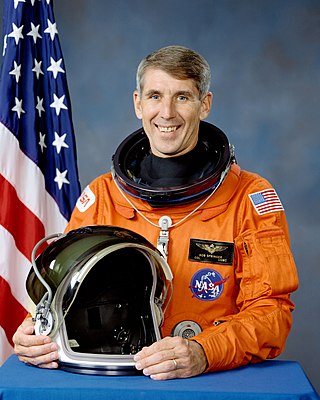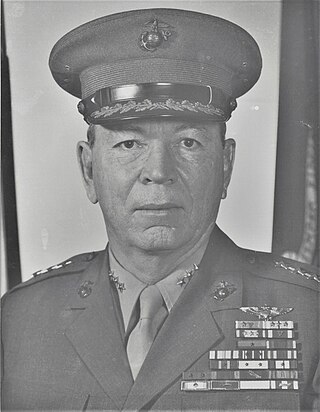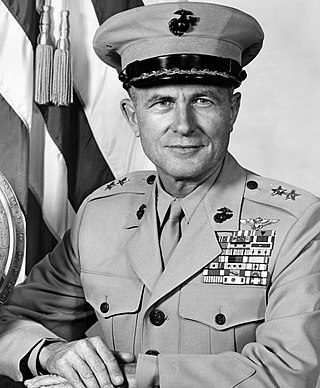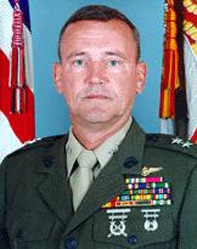
The Hawker Siddeley Harrier is a British jet-powered attack aircraft designed and produced by the British aerospace company Hawker Siddeley. It was the first operational ground attack and reconnaissance aircraft with vertical/short takeoff and landing (V/STOL) capabilities and the only truly successful V/STOL design of its era.

The Harrier, informally referred to as the Harrier jump jet, is a family of jet-powered attack aircraft capable of vertical/short takeoff and landing operations (V/STOL). Named after a bird of prey, it was originally developed by British manufacturer Hawker Siddeley in the 1960s. The Harrier emerged as the only truly successful V/STOL design of the many attempted during that era. It was conceived to operate from improvised bases, such as car parks or forest clearings, without requiring large and vulnerable air bases. Later, the design was adapted for use from aircraft carriers.

Kenneth Donald Cameron, , is a retired American naval aviator, test pilot, engineer, U.S. Marine Corps officer, and NASA astronaut.

Robert Clyde Springer is a retired American astronaut and test pilot who flew as a mission specialist on two NASA Space Shuttle missions in 1989 and 1990. A decorated aviator in the United States Marine Corps, Springer also flew more than 500 combat sorties during the Vietnam War. He has logged over 237 hours in space and 4,500 hours flying time, including 3,500 hours in jet aircraft.

Marine Attack Squadron 223 (VMA-223) is a United States Marine Corps fixed wing attack squadron that consists of McDonnell-Douglas AV-8B Harrier II (V/STOL) jets. The squadron is based at Marine Corps Air Station Cherry Point, North Carolina and falls under the command of Marine Aircraft Group 14 (MAG-14) and the 2nd Marine Aircraft Wing. The squadron uses "Stone" as its radio callsign.

Marine Fighter Attack Squadron 211 (VMFA-211) is a United States Marine Corps fighter attack squadron, currently consisting of F-35B Lightning II stealth STOVL strike fighter jets. Known as the "Wake Island Avengers" and the "Bastion Defenders", the squadron is based at Marine Corps Air Station Yuma, Arizona and falls under the command of Marine Aircraft Group 13 (MAG-13) and the 3rd Marine Aircraft Wing.

Marine Fighter Attack Squadron 311 (VMFA-311) is a United States Marine Corps fighter attack squadron consisting of F-35C Lightning II. Known as the "Tomcats", the squadron is based at Marine Corps Air Station Miramar, California and falls under the command of Marine Aircraft Group 11 (MAG-11) and the 3rd Marine Aircraft Wing.

Marine Fighter Attack Training Squadron 502 (VMFAT-502) is a United States Marine Corps fighter attack training squadron flying the Lockheed Martin F-35 Lightning II. Known as the "Flying Nightmares", the squadron maintains the history of Marine Attack Squadron 513 (VMA-513) which dates back to World War II and was decommissioned on 12 July 2013. The squadron is based at Marine Corps Air Station Miramar and falls under the command of Marine Aircraft Group 11 and the 3rd Marine Aircraft Wing

A naval aviator is a commissioned officer or warrant officer qualified as a crewed aircraft pilot in the United States Navy or United States Marine Corps. United States Coast Guard crewed aircraft pilots are officially designated as "Coast Guard aviators", although they complete the same undergraduate flight training as Navy and Marine Corps crewed aircraft pilots, and are awarded the same aviation breast insignia.

Marine Fighter Attack Squadron 542 (VMFA-542) is a United States Marine Corps Aviation fighter attack squadron flying the F-35B Lightning II. VMFA-542 is based at Marine Corps Air Station Cherry Point, North Carolina and falls under the command of Marine Aircraft Group 14 (MAG-14) and the 2nd Marine Aircraft Wing.

Major General Peter D. Williams is a retired United States Marine Corps general and an aviator. He served as the Inspector General of the United States Marine Corps in his last command.

The United States Marine Corps Aviation (USMCA) is the aircraft arm of the United States Marine Corps. Aviation units within the Marine Corps are assigned to support the Marine Air-Ground Task Force, as the aviation combat element, by providing six functions: assault support, antiair warfare, close air support, electronic warfare, control of aircraft and missiles, and aerial reconnaissance. The Corps operates rotary-wing, tiltrotor, and fixed-wing aircraft mainly to provide transport and close air support to its ground forces. Other aircraft types are also used in a variety of support and special-purpose roles. All Marine Corps aviation falls under the influence of the Deputy Commandant for Aviation, whose job is to advise the Commandant of the Marine Corps in all matters relating to aviation, especially acquisition of new assets, conversions of current aircraft, maintenance, operation, and command.

The McDonnell DouglasAV-8B Harrier II is a single-engine ground-attack aircraft that constitutes the second generation of the Harrier family, capable of vertical or short takeoff and landing (V/STOL). The aircraft is primarily employed on light attack or multi-role missions, ranging from close air support of ground troops to armed reconnaissance. The AV-8B is used by the United States Marine Corps (USMC), the Spanish Navy, and the Italian Navy. A variant of the AV-8B, the British Aerospace Harrier II, was developed for the British military, while another, the TAV-8B, is a dedicated two-seat trainer.

Lieutenant General Thomas H. Miller, was a United States Marine Corps Naval Aviator and test pilot. Miller saw active combat in World War II, Korea, and Vietnam. As a test pilot, he set a World Speed Record in an F4H-1 (F4B) Phantom. He was the first American to fly the Marine Corps' new AV-8A Harrier jet, capable of vertical takeoff and landing, orchestrating its procurement for the Marine Corps and oversee development of the concept during his career. For this effort, Miller was known as "the father of STOVL aviation in the USMC."
The US Navy had four programs for the training of naval aviators.

Jon M. Davis is a retired United States Marine Corps lieutenant general. His last assignment in the Marine Corps was as the Deputy Commandant for Aviation.

Arthur L. Nalls, Jr. is a retired United States Marine Corps officer, test pilot, and entrepreneur who owns and operates a unique air show business consisting of two Harrier jump jets as well as an L-39 Albatross. A former Guinness World Record holder for the World's Smallest Rideable Bicycle (1974), Nalls is notable for his contributions to the air show profession pioneering, restoring and flying uncommon aircraft. Nalls flew Harriers extensively in the military and developed a great enthusiasm for this jet capable of vertical/short takeoff and landing (V/STOL) operations. Supported by a group of pilots and maintainers, Nalls performs at air shows in the northeast United States and Canada.

Jennifer Marie "Jenna" Dolan is a colonel in the United States Marine Corps Reserve and former fighter pilot. During the 2003 invasion of Iraq, she became the first woman to fly the McDonnell Douglas AV-8B Harrier II aircraft in combat. The First Lady of the United States, Michelle Obama, recognized Dolan's transition from the military to civilian workforce as an example for others to follow. Dolan plans to join a small group of civilian pilots that fly the Harrier at air shows.

Robert Prescott Keller was a highly decorated Naval aviator in the United States Marine Corps with the rank of lieutenant general. He began his career as reserve pilot during World War II; he shot down one enemy aircraft and damaged two others during New Britain campaign. Keller distinguished himself again as pilot during Korean War and later reached general's rank during Vietnam War.

Arthur Tomassetti is a retired United States Marine Corps colonel, combat veteran, and test pilot who is notable for his work on the Joint Strike Fighter (JSF) and F‑35 Lightning II. During twenty-one years on the programs, he worked in key roles developing pilot interfaces, testing aircraft capabilities, fielding aircraft to operational units, and establishing the F-35 training organization that certifies US and international pilots and maintainers.
























